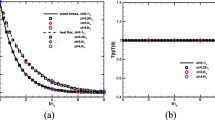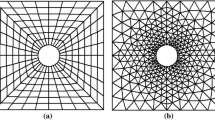Abstract
The direct simulation Monte Carlo (DSMC) method is the most mature and wildly used approach for nonequilibrium gas flow simulation. The phenomenological nature of this method brings flexibility to the computation algorithms. In this study, the theoretical foundations to decouple the molecular motion and collision within a time step are discussed in detail, which can be treated as criterions for the DSMC algorithms. Based on the theoretical developments, an improved local time stepping scheme is proposed, which specifies the movement time attribute and the collision time attribute for each representative particle. A free flow about a sphere body is considered as an example, which is compared with the calculations using the published local time stepping technique. The results show that the improved local time scheme is valid and is promising in realizing flow structures with strong variations.
Similar content being viewed by others
References
Bird G A. Molecular Gas Dynamics and the Direct Simulation of Gas Flows. Oxford: Clarendon Press, 1994
Wilmoth R G, LeBeau G J, Carlson A B. DSMC grid methodologies for computing low-density, hypersonic flows about Reusable Launch Vehicle. In: The 31st AIAA Thermophysics Conference. New Orleans: AIAA, 1996
Lumpkin III F E, Fitzgerald S M, Lebeau G J, et al. Study of 3D rarefied flow on a flat plate in the wake of a cylinder. In: The 33rd AIAA Thermophysics Conference. Norfolk: AIAA, 1999
Ivanov M S, Markelov G N, Gimelshein S F. Statistical simulation of reactive rarefied flows: numerical approach and applications. In: The 7th AIAA/ASME Joint Thermophysics and Heat Transfer Conference. Albuquerque: AIAA, 1998
Laux M. Local Tome Stepping with Automatic Adaption for the DSMC Method. In: The 7th AIAA/ASME Joint Thermophysics and Heat Transfer Conference. Albuquerque: AIAA, 1998
Teshima K, Usami M. DSMC Calculation of Supersonic Expansion at a Very Large Pressure Ratio. In: 22nd International Symposium on Rarefied Gas Dynamics. Sydney: AIP conference proceedings, 2001. 737–744
Bird G A. The DS2V/3V Program Suite for DSMC Calculations. In: 24th International Symposium on Rarefied Gas Dynamics. Monopoli: AIP Conference Proceedings, 2005. 541–546
Shen Q. Rarefied Gas Dynamics (in Chinese). Beijing: National Defense Industry Press, 2003
Nanbu K. Direct Simulation scheme derived from the Boltzmann equation. I. monocomponent gases. J Phys Soc Jpn, 1980, 49: 2042–2049
Legge H, Koppenwallner G. Sphere Drag Measurement in a Free Jet and a Hypersonic Low Density Tunnel. In: Rarefied Gas Dynamics VII symposium. Pisa: Tecnico Scientifica, 1970. 1: 481–488
Author information
Authors and Affiliations
Corresponding author
Rights and permissions
About this article
Cite this article
Cai, G., Su, W. & Hou, F. Theoretical development for DSMC local time stepping technique. Sci. China Technol. Sci. 55, 2750–2756 (2012). https://doi.org/10.1007/s11431-012-4913-7
Received:
Accepted:
Published:
Issue Date:
DOI: https://doi.org/10.1007/s11431-012-4913-7




